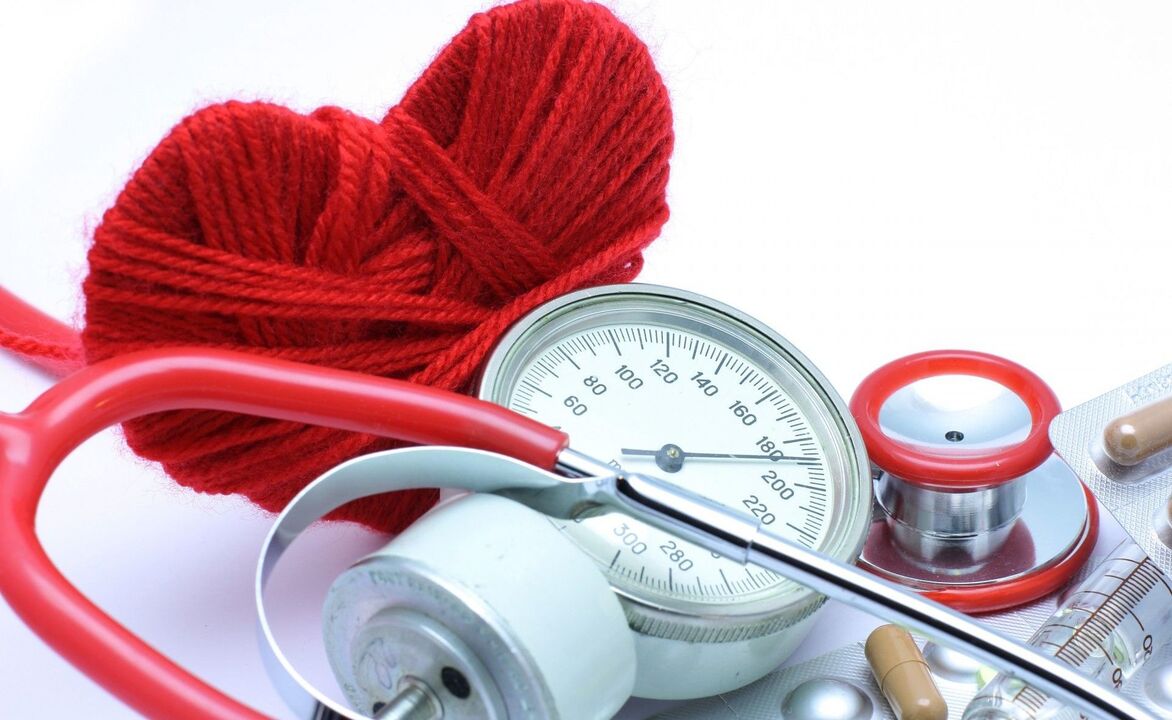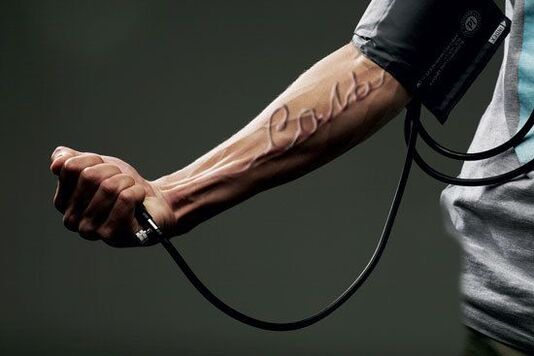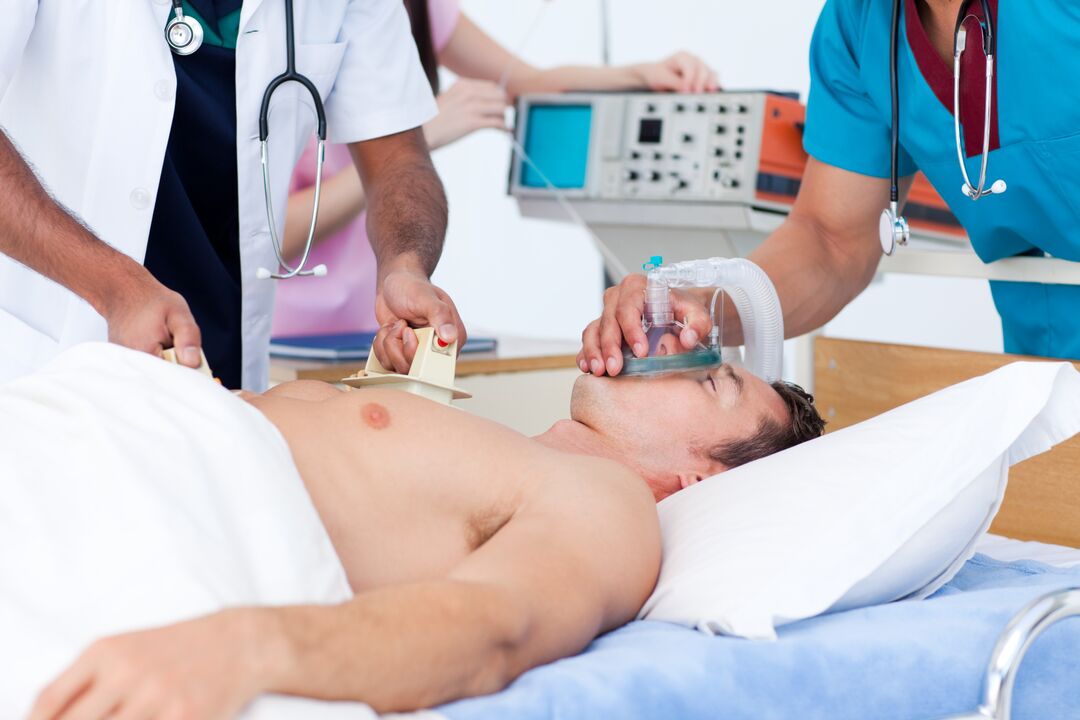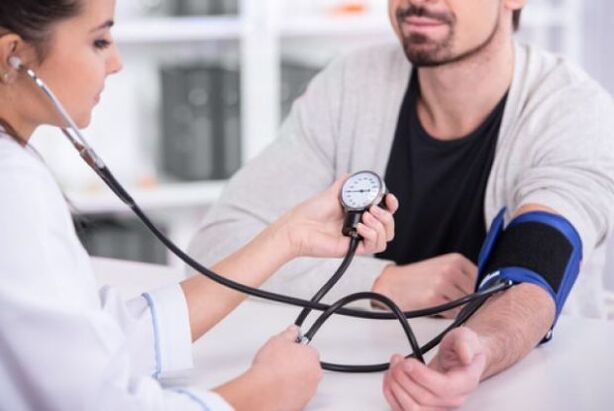According to the World Health Organization, high blood pressure is one of the most common diseases. Hypertension occurs in one in three people and is characterized by high mortality in severe stages. Only a complex treatment that combines medication and maintaining a healthy lifestyle can be successful.

What is high blood pressure
Hypertension is a chronic disease and a pathological condition of the cardiovascular system. It develops due to the interruption of the work of the superior centers responsible for the function of blood vessels. Dangerous complications of hypertension with visceral disease.
One of the main manifestations of the disease is high blood pressure (blood pressure), which is lowered only after taking special and powerful medicines.
Hypertension refers to pressure starting at 140/90 mm Hg. Higher if confirmed in two medical exams.
There are several types of high blood pressure:
- primary arterial hypertension,
- Symptomatic arterial hypertension,
- chronic hypertension,
- Vascular hypertension.
Symptomatic or secondary hypertension accounts for only 10% of all reported cases of the disease. Hypertensive syndrome - the second name for the disease - is most often associated with systemic lupus erythematosus, urolithiasis, renal abnormalities and tumors, ischemia, intoxication in the third trimester, renal tuberculosis. Hypertension, although without its own signs and characteristics, seriously exacerbates the underlying disease.
Essential hypertension is a separate form of the disease.
Chronic high blood pressure is often caused by too much calcium in the blood, infectious diseases (which become chronic), diabetes, and genetics. It manifests as nervousness, absent-mindedness, fatigue and weakness, frequent numbness in the extremities, speech difficulties, left ventricular hypertrophy and frequent pain in the heart area.
How is high blood pressure formed?
The mechanism by which hypertension develops is as follows: Disruption of tone regulation occurs in peripheral blood vessels in response to stressors. The result is spasm of the small arteries, creating a syndrome of circulatory disturbance and dyskinesia. The secretion of neurohormones in the aldosterone system is markedly increased. This causes a delay in the vascular bed of sodium and water, which increases blood circulation and increases pressure. During disease, the viscosity of the blood also increases, which leads to a decrease in the rate of metabolic processes in the tissue. The walls of blood vessels increase in size and the spaces between them narrow, which affects blood flow. High levels of resistance in the periphery make the disease irreversible. Arteriosclerosis and elastic fibrosis develop due to increased plasma permeability and maceration of the vessel wall, which leads to severe changes in the tissue of certain organs.
Spontaneously, high blood pressure does not occur in humans. Often, hypertension precedes vegetative vascular dystonia (VD), which is often accompanied by varicose veins.
Varicose veins and hypertension are related: increased vessel wall activity in SVD leads to a decrease in their diameter. The resistance of blood vessel walls to blood flow increases, which increases blood pressure. Varicose veins are characterized by thickening of the walls of blood vessels, forming pockets and constrictions inside, which interfere with the normal flow of blood. The diseased veins are no longer able to cope with blood flow, resulting in the formation of edema in the tissue and chronic stagnation of the veins. This can develop into gangrene, sepsis and even death.
Disease classification
Hypertensive disorders vary in their causes of elevated pressure, organ damage, blood pressure levels, and disease duration. The disease can be benign, or slowly progressing, or rapidly progressing - malignant. More importantly, it is classified according to the level and stability of the pressure. distinguish:
- Standard GB (up to 129/85 mmHg),
- border (up to 140/90 mmHg),
- first-degree hypertension (up to 160/100 mmHg),
- 2 degrees (up to 180/110 mmHg),
- 3 degrees (over 180/110 mmHg).
Benign hypertension is divided into three stages. The first or lesser one is that the pressure rises to 180 to 104 mmHg, but returns to normal after a short break. Some people complain of headaches, sleep problems, fatigue and poor performance. However, in most cases, the mild stage has no obvious individual symptoms.
The second or intermediate stage is characterized by pressures up to 200 to 115 mmHg. at rest. It is accompanied by intense and throbbing pain in the head, dizziness, pain in the heart area. During the examination, damage to the heart was detected. Subendocardial ischemia is sometimes detected. Stroke and transient cerebral ischemia are possible.
The third or severe stage is accompanied by a steady and intense increase in stress. At the beginning of the phase, the increase in stress is intermittent and usually manifests itself after physical exertion, as well as changes in atmospheric pressure, and mood swings. It can be normalized after myocardial infarction or stroke. Headless hypertension often occurs after a heart attack. That is, only the systolic blood pressure or the pulse pressure is lowered.
Cause of disease development
The cause of high blood pressure is the disruption of the regulatory activity of the main part of the central nervous system, which controls the work of all internal organs. Often overworked and overworked, both physical and mental, chronic, persistent and intense restlessness, stress can lead to development.
Working at night and often in noisy environments can also trigger the disease.
At-risk groups include salty food lovers. Salt can cause arteries to spasm and prevent fluid from draining. Genetics plays an important role. If two or more relatives have high blood pressure, the disease is more likely to occur.
Some diseases can also cause high blood pressure to develop. These include:
- adrenal and kidney disease,
- thyroid disease,
- obesity,
- diabetes diabetes,
- tonsillitis,
- Atherosclerosis.
Among the women at highest risk, those in menopause. This is due to hormonal changes in the body, mood deterioration, and neurological reactions. About 60% of women's disease occurs during menopause.

In men, age and sex determined the increased risk. About 9% of men develop high blood pressure in their 20s and 30s. At 40, the percentage increases to 35, and after 65 - already 50%. High blood pressure is more common in men under the age of 40 than women. In the older group, this proportion changed - which could be explained by a large proportion of male mortality due to complications.
High blood pressure is caused by fatigue and bad habits. The components of tobacco smoke can cause vasospasm and damage the thin walls of arteries. Physical inactivity is accompanied by a slow metabolism, and if the load increases, the untrained heart will tire many times faster.
symptom
The clinical symptoms of initial hypertension may be mild. For a long time, a person may not even be aware of the increase in pressure in the vessel and the development of the process. The early and first signs of high blood pressure are increased irritability and fatigue for no apparent reason.
Symptoms of early hypertension: neurosis, weakness, sleep disturbance, noise and tinnitus and dizziness, palpitations.
People notice a drop in efficiency and a lack of concentration. Short of breath. Headaches with hypertension are more common in the temporal and occipital regions in the morning. By the end of the day, the supine position may increase. They are associated with violations of the tone of venules and arterioles. Symptoms of high blood pressure include pain in the heart area. This is due to the increased work of the heart muscle to overcome the increased resistance. As a result, a dissociation occurs between the needs and capabilities of the heart muscle, leading to angina.

Later signs of high blood pressure are the veils and flashes of the "fly" in front of the eyes, as well as other light checks. They can be explained by spasms of retinal arterioles. Malignant hypertension can be accompanied by retinal hemorrhages, leading to blindness. In rare cases, symptoms of high blood pressure appear as vomiting, swelling of the hands and fingers, chills, in the morning - heaviness of the eyelids and puffiness of the face, excessive sweating.
Complications During Hypertension
Hypertension Complications:
- hypertensive crisis,
- visual impairment,
- Circulatory disorders in the brain
- nephrosclerosis,
- subarachnoid hemorrhage,
- dissection of aortic aneurysm,
- slow movement,
- damage to target organs (kidneys, heart, brain, veins and arteries, fundus vessels),
- Hypertensive cardiomyopathy (HLH, left ventricular hypertension)
- Hyperosmolar vascular dystonia.
Hypertensive crisis
First, you need to understand what a hypertensive crisis is. The term refers to an acute and marked increase in blood pressure accompanied by the characteristic symptoms of the disease. In addition to high blood pressure, it can also be caused by:
- chronic and acute glomerulonephritis,
- late pregnancy poisoning,
- renovascular hypertension,
- benign brain tumor,
- heavy metal poisoning,
- kidney failure.
Hormonal imbalances and sudden changes in weather can lead to a crisis. One of the most common causes is trauma of a psycho-emotional nature. Symptoms: Severe headache, nausea and vomiting, dizziness, fainting, short-term blindness and other visual disturbances, weakness, mood swings, tearing. Brain symptoms:
- vasospasm,
- Violation of the permeability of the vessel wall,
- Plasma enters the medulla, causing edema.
In the initial stages of the disease, the crisis is mild and short-lived.

Danger of crisis in possible development:
- retinal detachment,
- stroke,
- acute pulmonary edema
- heart disease asthma,
- myocardial infarction,
- Angina pectoris.
Complications of hypertension pose a serious threat to human life and require regular monitoring by a doctor.
slow
A common and dangerous complication of hypertension. It manifests according to form. Mild forms may be ignored. Severe, frequent, and prolonged dizziness from high blood pressure may indicate a distinct form of the disease. In addition, symptoms include - a state of semi-fainting and frequent fainting, sudden changes in pressure. Severe forms are accompanied by fainting and short-term cardiac arrest. Bradycardia with hypertension can be treated with homeopathy and medication. Diuretics, alpha-blockers, nifedipine are usually prescribed. From homeopathy, calendula, St. John's wort, strawberries, shakers are prescribed.
Complications include the following hypertensive syndromes:
- myocardial damage,
- kidney damage,
- vascular encephalopathy,
- Hypertensive Syndrome.
Relevant clinical conditions: ischemic stroke, CHF, coronary revascularization, renal failure, arterial disease, papilledema.
target organ damage
a heart
In most cases, left ventricular hypertrophy is present. This happens because the heart muscle has to work very hard to push blood into the deformed blood vessel. Such work can lead to thickening of the muscle walls and poor blood circulation. This is dangerous for muscle strain and heart fatigue. Another pathology is a violation of the diastolic function of lzh. The increasing fatigue of the heart muscle prevents it from adopting a relaxed position. The thickened wall cannot relax during diastole, when oxygen saturation usually occurs. This all leads to a third pathology - chronic insufficiency. It develops due to persistent hypoxia. Treating the disease is very difficult, and in combination with other conditions, it can lead to death.
vessel
Due to the contraction of the muscle layer, the arteries of hypertensive patients are in a constant state of stenosis. This causes blood vessels to stop relaxing and muscle tissue to be replaced by connective tissue. This is called vascular remodeling. Vision loss, peripheral atherosclerosis of the extremities, and other diseases are associated with this complex and irreversible consequence.
brain
Almost 25% of strokes are caused by bleeding. Hypertension is the main cause of bleeding and its mortality rate is high. Insufficient blood supply to the brain can lead to an ischemic stroke. This complication accounts for more than 70% of cases. It is caused by narrowing of arteries in the brain or by a blood clot blocking the tube. Another pathology is hypertensive encephalopathy. This is an emergency with severe headache, high blood pressure, neurological symptoms. If you have high blood pressure, you are at risk of developing cognitive impairment and dementia. These are changes in the subcortical material and brain shrinkage that are responsible for the violation of thought processes.
kidney
One of the most common complications is microalbuminuria. The earliest signs of kidney damage and the development of kidney failure. Chronic renal failure is characterized by a loss of the kidneys' ability to remove metabolites from the blood.
Disease diagnosis
High blood pressure can only be effectively treated if diagnosed early and followed by all rules and recommendations. Hypertension is not always an indicator of hypertension, it can be situational. Repeated doctor visits were not detected. A single measurement of pressure may not reveal disease: as symptoms recur, it is necessary to measure blood pressure dynamically. After a diagnosis is made, doctors perform a differential diagnosis to determine the symptomatic form of the disease.

pressure measurement
To determine the extent and presence of disease, dynamic pressure measurements are used. The execution is as follows: The atmosphere should be comfortable and calm. Measurements were started within ten minutes of the patient's admission. One hour before your visit, excluding smoking, consumption of any food and strong beverages (tea, coffee, alcohol), any physical activity, use of eye or nose drops. Blood pressure readings were taken from the patient's hands during the first treatment, and a second measurement was taken 2 minutes later.
Readings differ by more than 5 mm Hg. Continue to measure the arm under high pressure.
Treatment of high blood pressure
How high blood pressure is treated depends on the stage of the disease, complications, age, and many other parameters. Treatment options are selected by the attending physician. The desire to fight the disease alone can turn disastrous. Modern treatment of high blood pressure begins with non-drug approaches that increase the effectiveness of drugs several times over. You need to start by establishing a routine, removing any stress and not forgetting exercise and long walks. An important aspect of treating high blood pressure is diet. Patients should refuse or significantly reduce salt intake, reduce alcohol consumption, and completely eliminate alcoholic beverages and coffee. If you follow all the recommendations, you can avoid medication for the disease.
In treatment, what is important is not only how to deal with high blood pressure, but more importantly how to eliminate the causes of high blood pressure.
Usually medicines are used to treat:
- diuretics,
- inhibitor
- type 2 receptor antagonists
- Calcium channel blockers.
Blood Pressure Medications - Prescription Only
Homeopathy
Considering how to get rid of high blood pressure, homeopathy deserves attention. They are usually recommended when the target organ is already affected. Homeopathy for high blood pressure has an important advantage: mild effects. The drug has no contraindications or side effects. The downside is that homeopathic treatment is rather slow. When choosing this method, consider:
- Homeopathic medicines are prescribed at the same time as medicines,
- Combining medication and a healthy lifestyle
- With an average degree of risk, this type is usually the only possible one.
Hospitalization for Hypertension
Hospitalization is usually due to complex hypertensive crisis:
- acute hypertensive encephalopathy,
- heart disease asthma,
- Pulmonary Edema,
- acute coronary syndrome (unstable angina and myocardial infarction),
- aortic aneurysm,
- severe arterial bleeding
- eclampsia.
After admission, the clinic's doctor begins the main diagnostic actions:
- Blood pressure ambulatory was measured every 15 minutes,
- electrocardiogram,
- General analysis of blood and urine,
- echocardiogram,
- For the detection of potassium, sodium, urea, calcium, creatinine, fibrinogen, coagulation,
- Ophthalmoscope.
In addition, the patient must make an appointment with a neurologist, Reberg's test, and a cerebral rheometer, as well as determine the type of cerebral hemodynamics. While in hospital, hospitalization depends on the presence of complications, the severity of the attack, and other medical conditions. First aid is aimed at reducing left ventricular activity and eliminating the following symptoms:
- peripheral vasoconstriction,
- cerebral ischemia,
- heart failure.
Very important in the management of complex episodes are the introduction of antihypertensive drugs, ICU admission and regular blood pressure checks.
Non-drug treatments for hypertensive states include immune boosting, body cleansing, massage, gymnastics, and diet. It's important to follow your doctor's instructions and not go against the established treatment regimen.
How to live with high blood pressure
For people diagnosed with high blood pressure, how long someone with high blood pressure can live is an important question. The consequences of the disease depend on the stage and nature of its course. Severe forms, vascular damage, third stage of the disease and destruction of target organs worsen the prognosis. Heart attack and stroke, acute heart failure can lead to premature death. The prognosis is poor for those who fall ill at an early age.
The life expectancy of a person with high blood pressure depends not only on the correct medication and regular doctor visits, but also on the individual's attitude and adherence to ground rules. These include:
- mental climate,
- diet,
- Physical exercise,
- There are no bad habits.
Another important condition is understanding what disease it is, how it develops and what effect it has on the entire body. In order to understand the characteristics of the disease process, medical education is not necessary. There are many good books and manuals written for ordinary people. One of them is A. Yakovlev's "Prevention of Medical Diseases", which provides a brief and clear overview of the main regulations for hypertension, as well as the most popular treatment options for hypertension.
psychological climate
Once you understand how to treat high blood pressure and choose a treatment, you need to turn to an equally important issue - a healthy lifestyle. Night shifts, frequent fights, frequent and long-distance business trips, intense emotional stress, negative emotions, fear, anger are impossible. All of these conditions are accompanied by a massive production of adrenaline, which leads to disruption of the circulatory and nervous systems. It's important to control your emotions, think more positively, and exclude any sources of stress from your environment. Herbal tea, meditation, walking, doing what you love will all help.
By creating the most comfortable conditions around you, a person can increase the chances of recovery.
diet
Overweight and high blood pressure are incompatible. Even if there is no excess weight, treatment begins with nutritional correction. In the initial stage, this is enough to control the pressure and prevent it from increasing. There are several ways to lose weight with high blood pressure. Mainly calorie restriction. This can be achieved by eliminating or reducing sweets and fatty foods, flour products in the daily diet. Weight loss diets should not be confused with fasting: people with high blood pressure should not eat it. To lose weight and normalize blood pressure, you should also monitor the amount of animal fat in your food. Eliminate cholesterol-rich foods as much as possible and switch to low-fat fish, fruits and vegetables, and natural vegetable oils. It's worth giving up sausage, lard, meatballs, and fat, butter, and fatty cheese altogether.
Contraindications for high blood pressure - any drink and food that stimulates the nervous system. These include not only tea, coffee and wine, but also carbonated beverages, hot spices, scented spices.
It is important to include foods rich in potassium and magnesium in your diet. These elements have a great effect on the heart muscle, strengthening the walls of blood vessels and the nervous system. Large amounts of potassium are found in:
- Plum,
- apricots,
- cabbage,
- pumpkin,
- banana.
Magnesium rich:
- Buckwheat, oat and millet groats,
- carrot,
- beet,
- black currant,
- parsley and lettuce leaves
- Walnut.
One important rule: these products should not be mixed with milk. Calcium has a negative effect on the digestibility of the element.

Physical exercise
Complications of arterial hypertension and the disease itself do not mean that patients should abstain from any activity. Gymnastics, simple exercises, yoga or long walks, swimming are suitable for people with high blood pressure. Not only does this exercise bring positive emotions, it also helps fight overweight.
You should start with the easiest workouts and gradually increase the duration and complexity of your workouts. This also applies to swimming and walking.
The rehabilitation of the third stage of hypertension and complications of hypertension, stroke, coronary heart disease, angina pectoris, etc. , can only be carried out under the supervision of a doctor. Usually, for recovery, patients are sent to special nursing homes for treatment in nursing homes. This includes a full range of measures: proper nutrition, physical exercise, medication.





















